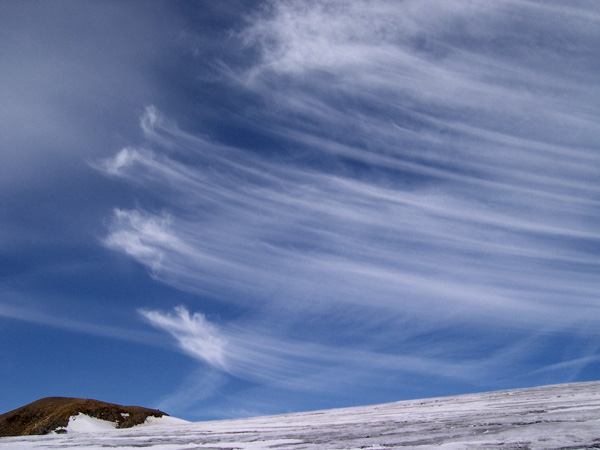
Cirrus uncinus e Cirrus fibratus- Foto di:
Massimo Riso
CIRRUS
Quale tempo?
CIRRUS
What weather?
[INGLESE] If clouds look as if scratched by a hen;
get ready reef your topsails then
[INGLESE] Horse’s manes and mares’ tails,
saylors soon shall shorten sails
[INGLESE] Mares’ tails: storms and gales.
Mackerel sky; not 24 hours dry
[INGLESE] High clouds indicate fine weather will
prevail;
lower clouds mean rain
[INGLESE] The higher the clouds the better the
weather
[INGLESE] When the clouds spread like a feather,
Mariners look for fair, good weather
Vero o Falso?
Le espressioni “mares’ tails” e “horse’s
manes” (rispettivamente code di cavalle e criniere di
cavalla) si riferiscono ai cirri. I cirri, formandosi ad
alta quota, sono costituiti da cristalli di ghiaccio.
Queste nubi appaiono bianche, sottili e fibrose. Esse si
presentano in forma di chiazze, piume e filamenti. Il vento
in alta quota è responsabile della loro eventuale struttura
stirata.
I cirri del bel tempo si distinguono perché poco estesi e di
struttura irregolare. Al contrario, la comparsa di cirri in
gran numero, disposti a bande in un cielo blu, annuncia
generalmente l'arrivo di un fronte caldo accompagnato da
precipitazioni. I marinai un tempo vedevano nei cirri degli
annunciatori di vento imminente.
True or False?
“Mares’ tails” and “horse’s manes”
refer to cirrus clouds. Cirrus clouds form at high altitude
and are composed of ice crystals. The clouds tend to be thin
and wispy and pointing in the direction of wind at their
elevation. They can be observed in a variety of shapes and
sizes. Possibilities range from tufts to featherlike plumes.
|